My usual method:
There are two parts to the cuticle area, the live skin (eponychium) and the dead skin (true cuticle). I have discussed them in great detail in this post and many others. I push back my live cuticle everyday; I have a problem, I know this. The reason is well documented in this post. In short, I apply moisture and massage and push them back. It's glorious and gives me longer nail beds. Now, the dead skin is a bit more difficult to remove. Here, I resort to chemicals; they are my friends and there is no reason why they should not be yours. They rarely disappoint. Take it from a chemist ;) ... I'm slightly biased, clearly. I showed how I remove my true cuticle in this video and post. To summarize, I like to be really gentle and use a q-tip to apply the product and remove the true cuticle. I think a wooden stick is also safe, but personally don't use if very often.
My regrettable method:
The following got me into some trouble...
The perpetrators:
Ignore the innocent bystander (wooden stick). He's an okay chap, but if you use him, be careful nonetheless.
It's true some metal scrapers are sharper than others. I thought I was safe. These felt pretty smooth to me.
I still used Blue Cross cuticle remover, but decided to use the metal scrapers instead of my usual q-tip. Here was the result...
WOOPS!
Ugh. PANIC! NAIL DAMAGE!
IDIOT.
Of course this needs fixing PRONTO!
DON'T PULL IT!! It may pull off more nail deeper down.
Instead...
Grab a semi rough nail file or buffing block, somewhere in the 220/320 or 400/600 range. I like the files from Tropical Shine for these types of jobs.
The first order of business was to remove that large flap. My nails are fairly healthy. I used the blue 220/320 file from Tropical Shine.
Next, I evened out the rest of the nail plate with a buffing block.
I am still in love with this sponge board. I used the 240 grit strength.
TA DA! Beautiful!
right?
NO. The following week I saw what those metal implements did to me...
OMG! Yes, my nails are yellow from Sinful - San Francisco. Don't judge me. Instead see the full story here.
The red circle shows the trauma the implements inflicted.
With time the damage will grow out.
As the damage grows out, the white spot appears and disappears depending on how moisturized my nail plate happens to be.
Here my nail was moist, the spot appeared to dissipate.
**Side note**
Isn't MOIST the best yet worst word ever?!
Here my nail was more dry, the spot appears more solid.
Moral of the story? I prefer to leave long hard metal objects for self defense purposes OR scraping barnacles of a hull, not cuticle removal.
How do you remove your cuticles?
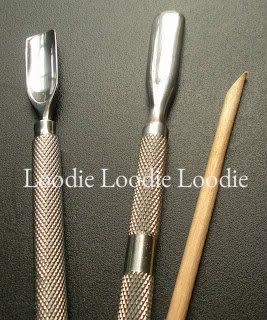


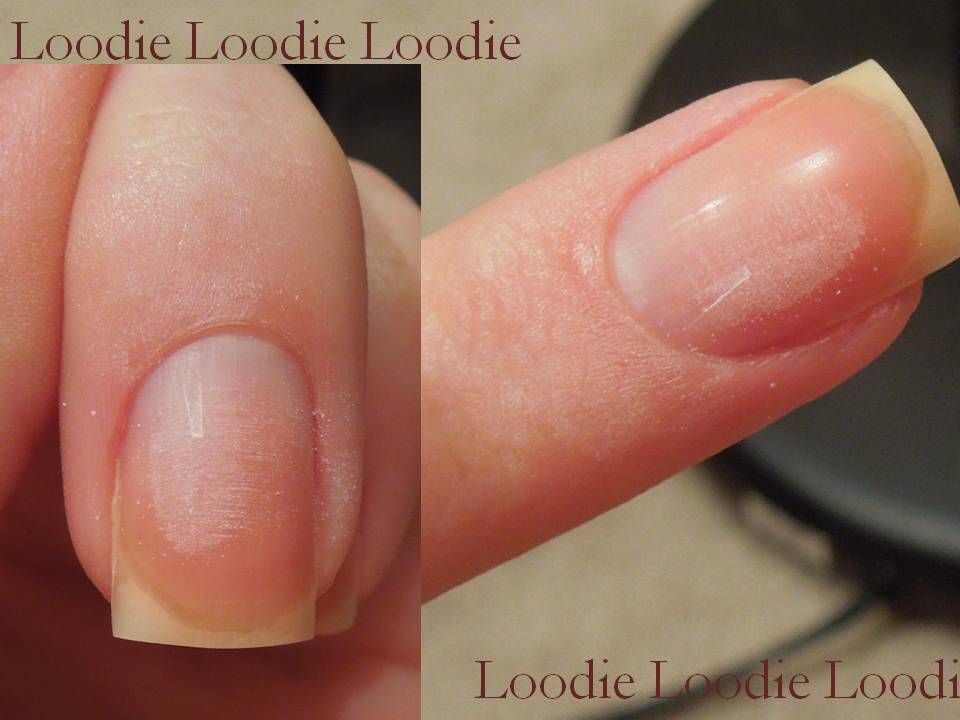


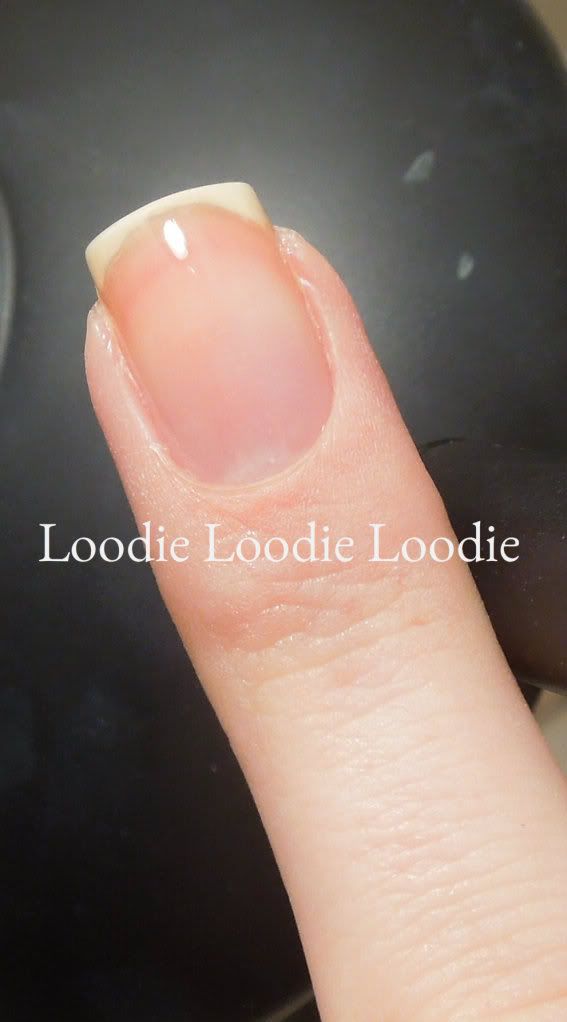
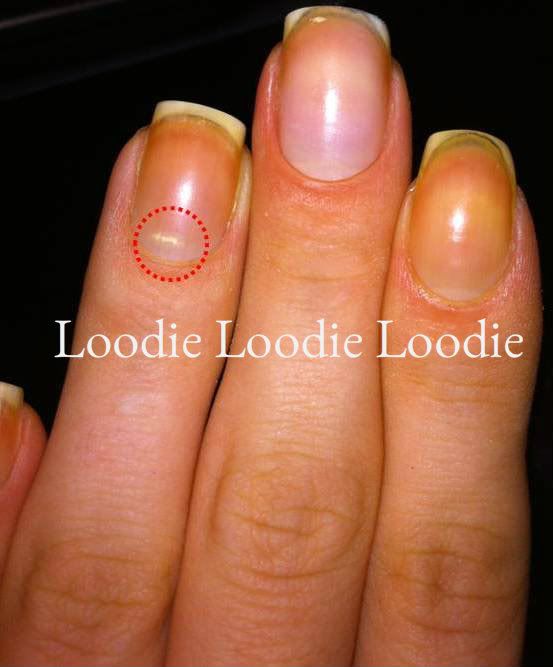

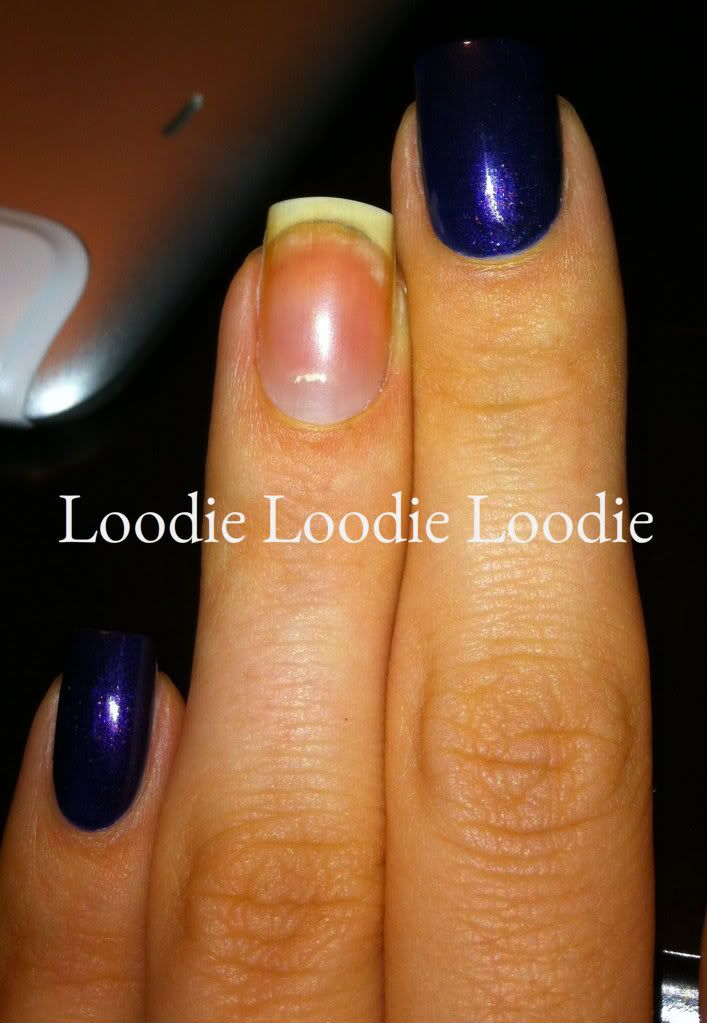
Funny, you and I are so in sync. I recently did a YT video in which I warned about the metal cuticle pusher. LOL!
ReplyDeleteI never get really perfect results, but I just drown my cuticles in Blue Cross for several minutes, and then go at them with a q-tip (I think that's what they're called?). And then brushing lightly with a tooth brush when I wash the left overs off.
ReplyDeleteThose metal thingies always scared me, and now I see that was actually a good thing!
Great post, thank you for it. I was planning to buy a metal cuticle pusher, but after reading this I know better. I'm sorry you had to go through this, but am also thankful that you shared your experience.
ReplyDeleteYou are too funny! Sorry about the nail injury! I hate those little white spots that seem to take FOREVER to grow out!
ReplyDeleteYikes! And here I was coveting the metal ones! I use Sally Hansen cuticle remover gel and a wooden stick. :)
ReplyDeleteI always use wooden sticks for getting rid of the dead skin, it works wonders! Lucky you didn't damage your nail too bad :).
ReplyDeleteI had mistakingly used one of those mini spoon shaped scraper for a bit, and stopped once I realized it was scraping away more than the dead cuticle. I have extreme peeling that I am growing out, buffing now makes them uber sensitive. I have the habit of using my thumb nails to scrape, is this good or bad? I know you should never use your nails as tools, but darn it they work really well and are just *there* all the time, begging to be put to good use. lol
ReplyDeleteOh ouch! poor nail! I can't say much...I was worrying at a bit of loose glitter on a mani just a day old and pulled it...BAD move! Layered peeling in the middle of my nail....I was so mad! I am buffing that bad boy like you say to keep it from getting worse. I am about 2 months from seeing the end of that mess. Lesson learned-if you use a bonding case coat...don't pick even a teeny bit! (moist IS a lovely word)
ReplyDeleteEeek!! I use ether the wood stick, or I use the plastic/rubbery ones from Sally's. I love my Sally's one.....but I lose it too often!
ReplyDeleteAnd lol at moist! I too, hear that word and think dirty thoughts......
Lol....me too but I wasn't going to admit it....
DeleteYou should be a teacher. These types of posts are so much more effective than what I learned in beauty school. My nails and cuticles are so much healthier since I started reading your blog. Thank you!!
ReplyDeletePs- metal scrapers are the worst! I figured that out in school because that's all we used.
How do you get such a perfect smooth rounded edge of polish around the cuticle? That's the part of painting I haven't mastered. Teach me, please.
ReplyDeleteHow do you get such a perfect smooth rounded edge of polish around the cuticle? That's the part of painting I haven't mastered. Teach me, please.
ReplyDeleteHow do you get such a perfect smooth rounded edge of polish around the cuticle? That's the part of painting I haven't mastered. Teach me, please.
ReplyDeleteSo THAT'S how it happened! I HAAAATE those metal things, that whole nail layer scraping thing has happened to me every time I use one... those metal bastards.
ReplyDeleteThat same thing happened to me when I used a non-acetone remover and a cotton ball to remove polish. I swiched to a polish remover for sensetive nails.
ReplyDeleteI use chemicals (a Swedish brand cuticle remover) to remove my true cuticle... and sometimes the pointy end of my glass nail file... SHHHH!!!
I end up doing that to myself using the finger nail of the other hand, yikes! And, I pulled... couldn't help it. I hope it doesn't happen again but if it does, I'll be buffing it!
ReplyDeleteI'm with you on the dangers of the metal implements. What seems to work best for me is just using my own nails to gently scrape across the surface of each nail. Nail on nail, seems pretty gentle, and I think it avoids the risk of damage. My thumb nails seem to be best for this job, left thumb to scrape across the fingers on the right hand, right thumb to scrape across the nails on the left hand.
ReplyDeleteI put the chemical remover on, massage it with a q-tip, then rinse my hands, and scrape (gently) with my own nail, over the surface of the nail while my hands/nails are still damp.
I have to be careful not to use the chemical type removers too often, I'm not sure my skin/nails really appreciate them, I do know I've had some irritation from time to time, I'm assuming it's from leaving them on too long.
I'm assuming my cuticles are pretty wimpy/low maintenance anyhow, sometimes I can scrape them off (gently) with a fingernail, just after washing my hands, no chemical remover involved. I'm assuming that they're easier to remove when saturated with water.
Yup, I stick w/orange sticks.
ReplyDeleteMy cuticles aren't so bad, it's the skin around the sides that are my battle.
Sigh.
Thanks for a great post!!!
oh wow. i always use a metal scraper (my favorite being from revlon), and thankfully i've never a problem. and i'm a klutz. although i usually work my cuticles before removing my old polish, so i think that helps a lot
ReplyDeleteI (almost) never push my cuticles, should I do it? When I did it a few times I used a q tip. I don't even have a metal tool like this
ReplyDeleteGreat post! I never use metal cuticle pushers, I have really sensitive skin, so I stick to either orange sticks, or q tips. And I moisturize like a boss
ReplyDeleteThose metal pushers are the worst. I did the same exact thing to one of my nails and I will never touch one again. I use wooden stick now.
ReplyDeleteI'm still trying to find the right level of cuticle care for my nails. I get pretty bad true cuticle build-up but my nails are so thin and peely that it seems like any sort of cuticle remover just makes the problem worse. I've been using Dermanail for roughly a month now and I'm still hopeful that it's going to help, and I've cut back my cuticle work to roughly every other week instead of weekly. If that doesn't help I'm probably going to have to ditch the chemicals. =(
ReplyDeleteI think I'll stick with an orangewood stick, so long as I remember that I don't need to press down I should be ok. I tried using a q-tip but it doesn't seem to remove anything for me and I end up irritating the live cuticle in the process.
I don't know if this will work for anyone else but a couple of times a week when my cuticles are nice and soft from a shower or bath, I use my towel to push them back. I just lay the now damp towel over each nail and push with the thumb of my other hand. It works a charm for me. I used to use my own nail, but one time when I got very carried away (back when I didn't do regular maintenance), I pushed, poked and prodded so long that a week or two later I saw a huge DENT emerging from under the edge of my cuticle. It took months for that sucker to grow out and it was deep and noticeable enough that I was asked several times what happened. That's when I started using the towel or a microfiber wash cloth.
ReplyDeleteYour attention to detail is extraordinary. Just got an OPI metal tool, going to bin it! Thank you so much for sharing this info.
ReplyDeleteI'm glad they don't sell metal ones around here, because I know me I would of bought one and used it straight away....glad the damage grew out quite fast for you :)
ReplyDeleteSorry sweetie, you've got this one wrong and you're giving a great tool a bad rap. And it pains me that so many of your fans believe you (which is what they're supposed to do since they're looking up to you as a source of knowledge.)
ReplyDeleteYes, you did scrape a little bit of nail keratin. That was from pushing down too hard. The way you handled it was perfect.
But the metal tool had nothing to do with the white spot that you noticed a week later. These types of white spots are bruises from an injury that happened while the nail was forming in the matrix. According to Doug Schoon, author of Nail Structure and Product Chemistry, states, "white spots found in the cuticle area are from one-month-old injuries, since that is about how long it takes the spot to grow past the eponychium."
It's physically not possible for your event to show up as a matrix bruise a week later. A common cause of these types of matrix bruises is when we're trying to open or force something, our hand slips and hits against something like a counter. It hurts momentarily, we move on, and forget about it.
~Ana from NailCareHQ.com
I am well aware white spots are caused by prior matrix damage (and they tend to reveal themselves more when the nail is dehydrated). I maintain I am not wrong with this post or the fact that care should be taken with hard metal implements. Metal implements are not all created equal. Some are in fact more sharp than others. Aside from that, it is very easy to jab oneself, not just the surface but the cuticle, which in turn may damage the matrix. I didn't just scrap a little bit of the nail surface. You have to realize the event in its entirety. When I was scraping the cuticle my hand slipped and jabbed my cuticle thus injuring the top of the matrix area AND scrapping the nail surface. This event is all too common when using hard sharp implements. I have been taking care of my nails for almost 20 years and as experienced as I am, this happens to me often when using these types of implements.
DeleteThe sentence you quoted is great and I know of Doug Schoon very well, but you have to remember there are other factors that come into play in real life. You can't just take statements you read in a book at face value and run with it. Consider the following real life factors before you make judgments and tell someone they are wrong:
1. Nail structure is the same on every one, BUT some people's nail beds are more exposed than others, thus their nail bed surface at the cuticle area may be much closer to the matrix, while others have a much thicker cuticle protecting the area between the nail bed surface and start of the nail matrix.
I have been pushing my cuticles back for so long and to such extremes the I have no doubt in my mind that the top matrix is located in very close proximity to where my nail bed surface ends at the cuticle. Thus in my nail situation, a blow to the cuticle is a blow to the matrix.
2. Everyone's nails grow at different rates. My nails grow fast.
To summarize: If my nail matrix sits very close to my exposed nail surface near the cuticle it would be quite easy to damage the top of the nail matrix with a blow to the cuticle area. I foresee it is completely possible to view the nail damage one week later since my nails grow fast. My personal experience has repeatedly proven this trauma is possible and not just coincidence. I am not trying to deter anyone from using metal sharp objects; I am just sharing my knowledge and experience considering my specific nail situation. Your experience of course may very well differ, and I am not going to tell you, you are wrong.
See my disclosure policy at the end of this blog page, but I do not claim to be an expert of any kind. This is my personal blog. It may be a guide for some, but it is definitely not intended to be a definitive source of any kind. To be frank, there is no such thing because in the end we are all different and thus have different nail situations.
New website
ReplyDeleteBeauty forums